The RSI Army (1943 1945)
French Version
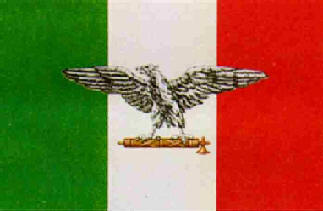
Traduction by Jacques Rouzineau
From Autumn 1943 onward, Italy has been facing a problematic period because after 20 years of totalitarian Facism, everything quickly collapsed. In fact, since 24th July 1943, Mussolini has been minored and deposed by the Facist Council in which Count Ciano, his son-in-law, and old friends like Grandi de Bono sit.
Chronology of year 1943 (Anno XXI Era Fascista)
At the end of 1942, Mussolini is depressed. News from the battlefront are bad and inner situation is not better. He sent his son-in law to met Hitler in November an d December but on 2nd December, he appeared again on the balcony of Palazzo Venezia and spoke to his people.
On 7th April 1943, he met Hitler at Klessheim and tried to convince the later to sign an armistice with the Russians to concentrate efforts on the Meditteranean battlefront.
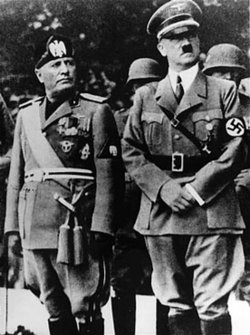 |
| The Duce and the Führer |
But on 9th June 1943 the Ango-Americans landed on Sicily beaches which they conquered within two months (17 Août). During this battle, Italian forces often surrendered without fighting for they felt exhausted and were strung out . For example Pantelleria and Lampedusa garrisons surrendered without resisting although they had plenty of food, ammunitiontions and equipment.
Owing to this, a group of facist ‘hiérarques’ led by Dino Grandi asked the ‘Gran Consiglio del Fascismo’ to meet. It has to be noticed that it had not been since 1939. Some days after the 19th July, Rome was bombered while Mussolini and Hitler were meeting in the North of Italy near the river Piave. On 24th July, the ‘Gran Consiglo’
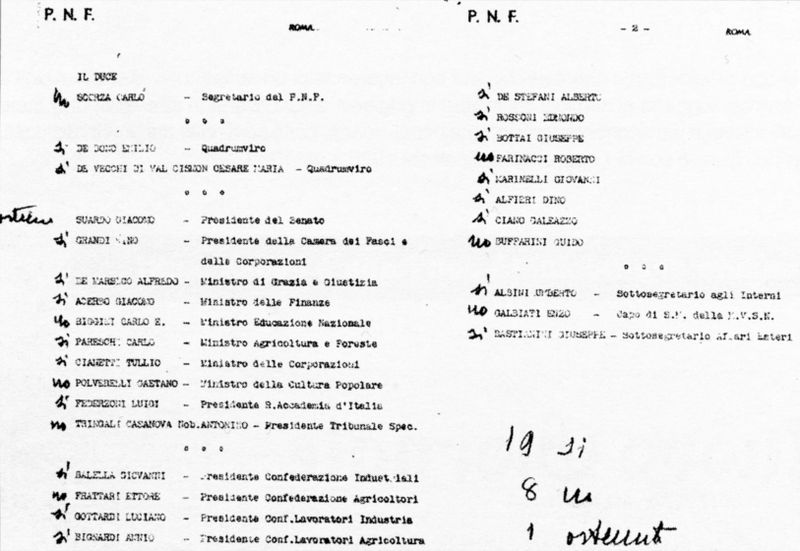 |
| Vote of the Great Facist Counsil of july 25th 1943 |
The order of the day of the ‘mischievous’ led by Dino Grandi is approuved (19 for, 7 against). Even Count Ciano, Mussolini’s son in law voted against him. This order of the day says that Mussolini will be discharged of all his responsibilities. But a problem arrised because the official texts sauys that the Kink alone can dismiss the President of the Council.. So Mussolini asked for an audience the day after but the King decided to replace him by Marechal Badoglio. Mussolini is arrested righrt away and driven to a secret location.
.jpg) |
.jpg) |
.jpg) |
King Vittorio Emmanuelle III
(1869 1947) |
the Duce (1883 1945) |
Dino Grandi (1985 1988 ) |
If the King acted like this, it was not only to save his dynasty has been tarnished from his alliance with fascism but also to send a man who became a burden but who was yet dangerous away from him. Just after this arrest, the King gave orders to negotiate with teh Allies and the armistice was signed at Cassabile on 8th September 1943.
This date was also the beginning of the civil war in Italy between Allies and Germans followers who had invaded the strategec points of the Peninsula.
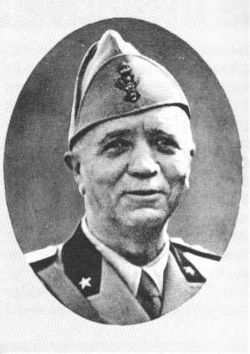 |
| Marshall Pietro Badoglio ( 1971 1956) |
Immediately, the King, apart of his family, Badoglio and his government took refugee in the Pouille under Allies jurisdiction and on 13th October, Badoglio declared war against Germany.
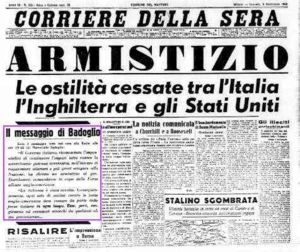 |
| Corriere della Sera September 8th 1943 |
Meantime, Mussolini, after he had been emprisonned in a Carabinieri garrison house at Rome has been transferred to Ponza on 27th July and to Maddalena Island betwwen 7th and 27th August. Then, he had been transferred by seaplane to a station of Gran Sasso to be once again transferred to Campo Imperatore on 28th August. On 12th September 1943, a commando of german parachutists (Fallschirmjäger-Lehrbataillon) under the command of Otto Skorzeni freed him with no opposition from the Italian troups. The name of the operation was ‘Operation Quercia’ or ‘Fall Eiche’ in German.
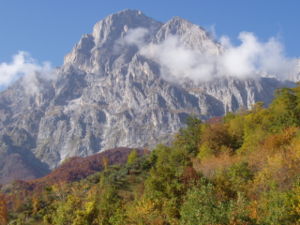 |
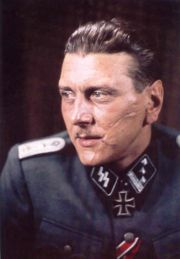 |
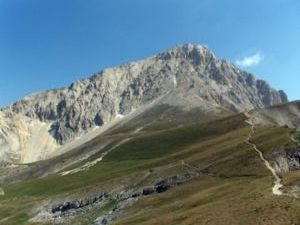 |
| Gran Sasso |
Otto Skorzeny (1908 1975) |
Gran Sasso |
On the 14th of September Mussolini was welcomed by Hitler at Rastenbourg and he encouraged him to form a government in Italy under the German ‘protection’ . On 18th September, he announced the renewal of ‘Partito Fascista Republicano’ during a meeting at Munich
Then, he created in the North of the Peninsula a puppet regime under the name of ISR or Italian Social Republic whereas, in the South of Italy, kingdom of Italy still existed under the control of the Allies. Mussolini organised his new state and doing so, he took revenge on some of his enemies at the Verone which took place from 08th to 10th 1944 at Castelvecchio. Mussolini subpoenaed some of the members of the Gran Consiglio del Fascismo under the charge of high treason because they had voted against him on 25th July 1943. Their votes had led to the fall of his regime. Four of the accused were sentenced to death and shot the day after: they were his son-in-law Count Ciano, marshal De Bono Giovanni Marinelli, Carlo Pareschi and Luciano Gottardi. Tullio Cianetti who had abstained from voting was sentenced to 30 years of emprisonment.
.jpg) |
.jpg) |
| Galeazzo Ciano (1903 1944) |
Emilio di Bono
( 1866 1944) |
Mussolini immediately decided to give laws to his new state but my study only concerns armed forces and many know that the dark side of the Salop republic was very important (If you want to know more about this, you may watch Pasolini film on the hundred days of Salo). So, Mussolini created armed forces to defend his state and to help the Germans. But he has no material and his dream to create a powerful army again was a dead letter.
He named Marshal Graziani who succeeded in creating an embryo of an army with units who had remained loyal to the Duce and with units who had been trapped in the middle of German units and who did not want to be treated like their fellow citizens on the Egee sea who had been meanly killed by Germans.
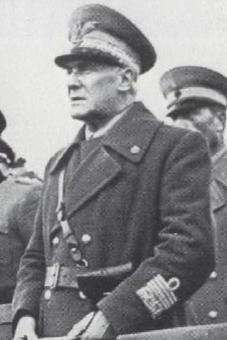 |
| Marshall Graziani ( 1882 1955) |
.
The ISR General Staff had planned an army composed of 10 Infantry Divisions, another 10 Panzer Grenadier Divisions on the German example and 5 Armoured Divisions. Two decrees created the ISR army on 28th October 1943. It was composed of officers from the ER who chose freely to join Mussolini and of soldiers who had been emprisoned after the armistice. It was also compulsory for those from the annual contingent of 1924/1925. This new army had to be trained in Germany.
According to historians and the ‘Ufficio Storico dello Stato Maggiore dell’Esercito’ from 558000 to 780000 men were recruited in this army plus 260000 workers.
At the Spring of 1944, archives quoted 327000 men.
Among the 810000 italian soldiers who were emprisonned by germans, 94000 chose to join the ISR (opportunists or true fascists). They were soon joined by 43000 men who served in the milice and 60000 more as auxiliaries for the Lutwaffe.
The most reliable number may be that from a SS report dated from April 1945 which said:
35000 soldiers in divisions ‘San Marco, Monterosa, Littorio and Italia’
72000 soldiers in ‘Guardia nazionale repubblicana’
22.000 men in ‘Brigate nere’
4800 in ‘Decima Mas’
1050 in the ‘legione autonoma Ettore Muti’
L' Esercito Nazionale Republicano
The armistice had left many servicemen without any clear orders. Thousands were simply off-handy and horribly murdered by the Germans others joined either the Allies or the Germans. But thanks to Operation Asche, the Allies quickly occupied important parts of the peninsula.
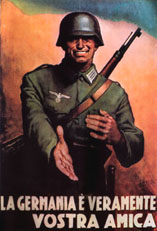 |
| No Comment |
At that point, a civil war was beginning to start in Italy. The ‘10th regiment Arditi’ was the 1st Unit to go on fighting against the allies. It joined the 2.Fallschrimjajer-Division which was quartered at the airport of ‘Pratica del mar’ near Romes. Some other units quartered in Russia at Jatomir, Kiev, Novocobiscoia, and Kirovgrag, in Holland at Eindhoven and Arnhem also rallied the german forces.
Another unit the Assault Legion ‘Camisas Negras ‘ and ‘M’ Tagliamento composed of veteran soldiers joined the SS Polizei Batallion ‘Gorice’, the ‘Vendetta’ legion did alike and its soldiers fought in Anzio.
Then, The ‘Esercito Nazionale Republicano’ from the RSI recruited 150.000 men who came from prisoners camps in Germany or were volunteers.
The training was very harsh in Germany and living conditions very Spartan. But, these men formed high valued soldiers and were they formed the skeleton of the first four divisions of the RSI.
Nevertheless , the Germans had not a high respect for Italian soldiers and once they came back to the Peninsula, they were only affected against partisans and used for police tasks. This led to many desertions.
In fact, they only fought during the Appenins battles in winter 44/45 and they did not show themselves unworthy of this.
After 8th May 1945, many of them knew bad fortune.
.jpg) |
| The End for the RSI Milan Piazza Lorretto April 29th 1945 |
.jpg) |
(1).jpg) |
| End for ENR Caserta Surrender( 1 ) |
| End for ENR Caserta Surrender(2) |
|
The main units from the ENR are:
Firstly in Italy controlled by the RSI, these units were divided in Comandi Militari Regionali (CMR) and Comandi Militari Provinciali (CMP)
The CMP were:
200th Roma
201st Florence
202nd Bologna
203rd Padoue
204th Trieste
205th Milan
206th Turin
207th Perouse
208th Macerata
209th Chieti – L'Aquila
210th Alessandria
Each of these C.M.R. was composed of a command (a HQ with services and a Régional Company or Batallion)
In addition, every ‘Provincie’ ( equivalent to a district ) had one CMP with its own General Staff with its provincial company or batallion.
All sorts of services including artillery schools, transport, police, military engineering … belonged to these ‘Provincie’
Excepted the ‘Littorio’ division which was included in the 86th German AK all the of t he Italian divisions were strenghtened with two German divisions and some Bersaglieri batallions, the ‘Brigate Nere’ and some elements from the G.N.R
All these units have formed the ’Armata Liguria’, under the authority of General Graziani, since 2nd August1944. It was the only case where German iunits were subordinated to Italian command. This army enrolled approximately 300.000 men.
2nd Littorio Division (Grenadiers)
This Division was called ‘Granatiere’ because at the end of the war the Germans gave this name to all new units. . In fact, it was not a ‘true’ grenadiers division . Only an self-supporting batallion was formed under the German example.
It went to train in Thuringe Its commander was General Tito Augusti It was composed of 17000 men. It came back to Italy in October 1944 and after a short stay in Emilie and Lombardie, it was arrayed in The Western Alps on 3rd december 1944 on ‘Cima del Diavolo’ where it stayed until the end of the war.
Composition :
General Staff
2nd Reco Btn with 2 squadrons equipped with heavy guns, anti tank and AA supports
2nd heavy Anti Tank co
3rd IR "Littorio"
1st 2nd 3rd Infantry Btn
103rd Anti Tank Co
4th Alpini Rgt "Littorio"
1st 2nd Btn et 3rd Btn Edolo
A Mules Parc
104th Anti Tank co
102nd complementary Btn "Littorio"
2nd AR "Littorio" with 4 batallions (3 groups 75mm and 1 group 105 mm )
2nd Signals Btn
2nd Mountain enginners Btn
2nd Btn from Traina
2nd medical Co
201st medical Co
2nd medical transport troop
2nd butchery Co
2nd bakery Co
2nd logistic Co
2nd vet Co
2nd MP Co
1st and after 4th Division Monterosa
.jpg)
This division was the first of the big units to be formed in December 1943. Its first elements were sent to Germany to train at Munzingen camp. This training was very important because German methods were based on living experiences. At the eb=nd of its training in July, the division was sent back to Italy under the command of General Mario Carloni.
On July 1944, it was composed of 20000 men (650 officers among them). It was armed with 1000 machine guns, 50 80mm mortars, 36 75/13 howitzers, 12 105/17 howitzers, 21 57mm guns, 36 Panzerschrecks, 144 panzerfausts, 12 20mmAA guns, 24 flamethrowers, and 6 armoured cars. There were also some German elements to do the mink between German and Italian troups. At the end of July 1944, it was placed under the order of german General Jam in the Corpo d’Armata Lombardia who was himself under the order of Marshal Graziani (Armata Liguria)
.jpg) |
| Liguria 1943 1945 |
.
It had to defend all the Ligure coast from any allies landing. So the troups were arrayed from Gênes to La Spezia. It had to watch the coast and to fight partisans. At the end of September 1944 a fighting group, originally from Bassano and Tirano battalions aznd from Vicenza artillery group, was formed to help the 5th German Mountain Division based on the French border. In addition, the fight on the Gothic line asked for more men and vehiclesand so, the number of men warching the caoast was even more reduced. On 16th October 1944, the division left the Ligure Coast to settle oin the Gothic Line.
.jpg) |
| Gothic Line 1944 1945 |
At the end, the elements were deployed on 3 different fronts, most of them facing Brazilian troups on the Appenins
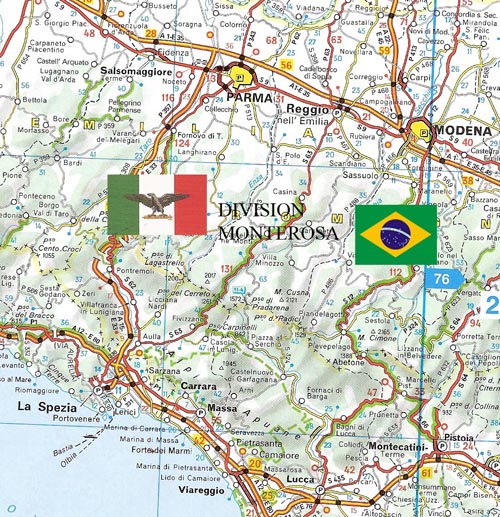 |
| Apennins Winter 1944/1965 |
.
Another group was arrayed in the Alps where winter slowed some operations but not the artillery battles. Fights started again on Spring and the order to climb down to the valley came on 24th and 25th April.
The division surrendered and sometimes, they were some violent scenes on survivors made by some men from the Italian resistance.
1000 soldiers from the division died in all the fightings during this period.
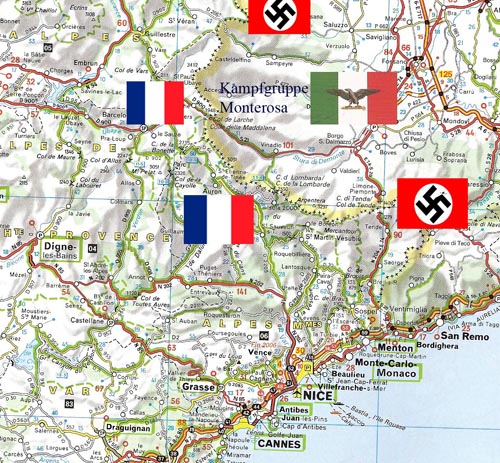 |
| French Alpes Winter 1944 /1945 |
Composition :
Division HQ
23rd ‘Fiamme Rossa’
1st Alpini Rgt Monterosa
’Aosta’ Btn
’Intra’ Btn
’Bassano’ Btn
A Mules Parc
101st Anti Tank co
2nd Alpini Rgt Monterosa
’Brescia’ Btn
’Tirano’ Btn
’Morbegno’ Btn
A Mules Parc
102st Anti Tank co
1st RAM ‘Monterosa’
1st Artillery Btn ‘Aosta’
2nd Artillery Btn ‘Bergamo’
3rd Artillery Btn ‘Verona’ and then ‘Vicenza’
4th Artillery Btn ‘Mantova’
1st tramsmission Co
1st Mountain Btn
1st Train Btn
1st medical Co
101st medical Co
1st medical transport troop
1st butchery Co
1st bakery Co
1st logistic Co
1st vet Co
1st MP Co
3rd Marine Infantry Division ‘San Marco’ (In spite of its name, it was reattached to the Army)

Historical report
It went to ‘Grafenwohr’ training camp in Sax. It was under Général .Princivalle’s command from 28th November 1943 to 23rd August 1944 then under Amilcare Farina’s command from 24th August 1944 to 30th April 1945.
It came back to Italy to be deployed in Ocidental Ligurie between Arenzano and Cape Berta on a line 75km long. At the end of October 1944, some elements joined la Monterossa in the Appenins at the Passo dell’Abetone (2nd Bat.from 6th Regiment, and 3rd Bat. From 5th Regiment). Other elements stayed on the coast where they only surrendered (after it had been accepted) on 23rd June 1945.
So, they were the last RSI forces to surrender.
Composition :
Division HQ
3rd Btn. Reco a heir from 2nd Btn from 10th Rgt d ‘Arditi’
5th Marine Infantry Regiment "San Marco" (with 3 Btns)
6th Marine Infantry Regiment "San Marco" (with 3 Btns)
53th Btn (replacment)
3rd Artillery Regiment"San Marco" (with 4 Btns)
3rd tramsmission Co
3rd Mountain Btn
3rd Train Btn
3rd medical Co
301st medical Co
3rd medical transport troop
3rd butchery Co
3rd bakery Co
3rd logistic Co
3rd vet Co
4th then 1st Bersaglieri Division "Italia"

Historical report
The division trained at Heuberg in Würtenberg under General Giardina’s command till 29th November 1943, then under Général. Carloni’s command till 15th July 1944, then under Général Guido Mainardi’s command till 22nd February 1945 and to finish, under Général. Carloni’s command till 29th April 1945.
It was first composed of 14000 men but soon , they were only 10000. It came back fromGermany in December 1944 and was deployed betwwen Parme Fidenza and Salsomaggiore. At mid-January 1945, it was deployed in the Appenins to replace elements from divisions Monterosa and San Marco. It surrendered with war honour at Medesano.
Composition :
Division HQ
2nd Btn. Reco
7th Bersaglieri Regiment "Italia" (with 3 Btns)
107th AC company
8th Cacciatori degli Appennini Regiment (with 3 Btns)
108th AC company
4th Reco Btnth heavy AC Company
104th replacment Btn "Italia" (with Btns)
4th tramsmission Co
4th Mountain Btn
4th Train Btn
4th medical Co
401st medical Co
4th medical transport troop
4th butchery Co
4th bakery Co
4th logistic Co
4th vet Co
4th PM section
MARINA NAZIONALE REPUBBLICANA
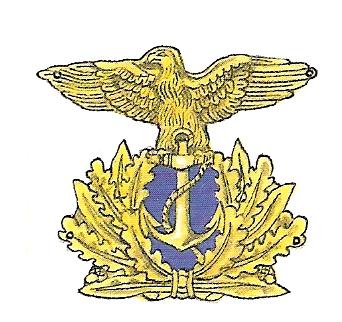
It was composed of 26000 men. Both French Navy and Italian Regia Marina had the same lot.. Indeed in 1939, these two countries had a powerful and new fleet. But three years later, they had lost all supremacy over the seas.
After three years of heavy loss, the Regia Marina is still powerful. After the cease fire, the fleet must surrender. So, it went to Malta to surrender but it was attacked by German planes which sunk Roma Battleship killing Admiral Bergammi. Some rumours have said that Admiral Bergammi did not want to go to Malta but to Spain which was a neutral country.
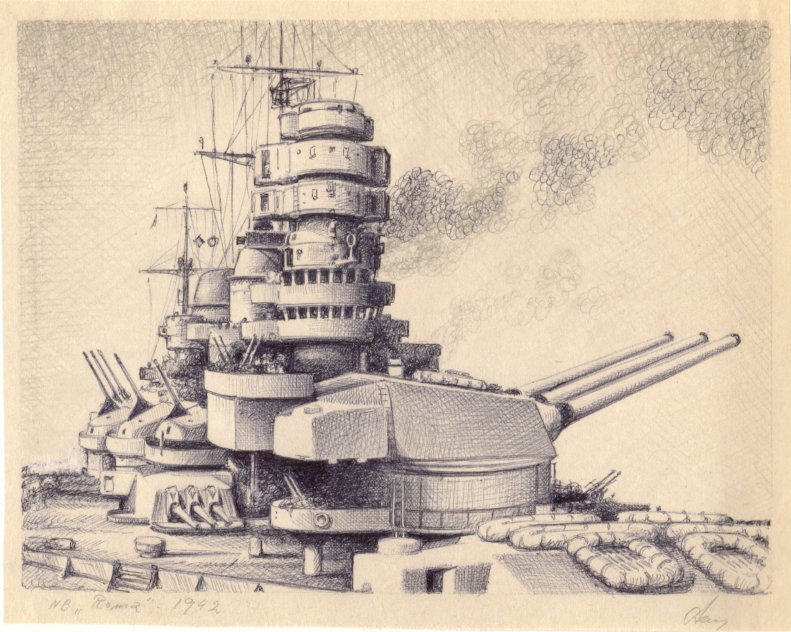 |
| Battleship Roma |
In the harbours which were still under German command, some old ships remained. Some of them were destroyed by their crew. Germans took some small units like torpedoes speedboats or some auxilliary ships.
But the best Division of the Regia Ejercito was Division ‘Decima’ which originated from Xmas Division Flotilla. This ‘flotilla’ had had some success against allies shipsand as soon as the cease fire was procclaimed, its commander the Prince Junio Valerio Borghese went to meet the Germans to offer his services. He recruited in all the Peninsula and succeeded in forming a division. When the RSI was born, this division was subordinated to Marina Nazionale Republicana but it kept its autonomy and obeyed only to Germans. It fought at Anzio, in the North of Italy and in Yougoslavia against partisans.
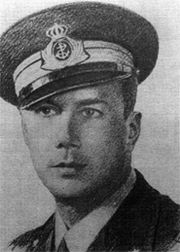 |
Prince Junio Valrio Scipione Borghese (Black Prince)
1906 1975 |
.
Composition :
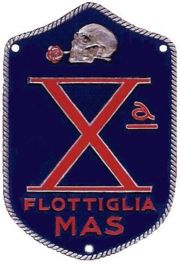
- 1st combat group
‘Barbarigo’ riflemen Btn composed of men who fought at Anzio
‘Lupo’ Btn
a rowers and parachutists Btn with 1 Rower Co and 3 parachutists Cos
Artillery Btn ‘Colleoni’
1st ‘Freccia’ co
- 2nd combat group
‘Fulmine’ Riflemen Btn (ex Maestrale)
‘Sagittario’ Riflemen Btn
‘Valanga’ mountain enginnering Btn
‘Castagnacci’ recruits Btn
‘Giussano’ Artillery Btn
‘San Giorgio’ mountain Artillery Btn
‘Freccia’ enginnering Btn (2nd and 3rd cos)
Indépendant Units
‘Risoluti’ Btn
‘Giobbe’ Btn (ex Ardimento) Btn
‘Longobardo’ Btn
‘Pegaso’ Btn
‘San Giusto’ Btn
‘Scire’ Btn ( a Borghese submarine which was sunk in Merditerranea)
‘Serenissima’ Btn
‘Vega’ Btn
‘Adriatica’ Co
‘D'Annunzio’ Co
‘Sauro’ Co
‘Operativa’ Co
‘Mai Morti’ Co
Auxilliary Women Services
Some batallions took the name of ships from RM.
Naval Units
Commandante Todaro school (Speedboats)
underwater driving school
underwater assult units
‘Gamma’ group (rowers)
"Commandante Moccagatta" school
Some speedboats and a unit called ‘Venise’ to put sea mines
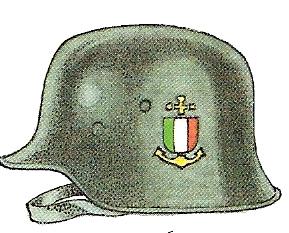 |
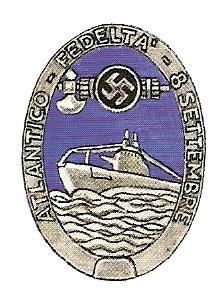 |
| Helmet RSI Bordeaux barrakcs (France) |
Bordeaux Barrack |
At Bordeaux, they were some submarines with the ‘Divisione Atlantica Fucilieri di Marina’ (3 Marine riflemen cos et 1 marine artillery co)
"Longobardo" Flottilla with 22 pocket submarines.
AERONAUTICA NAZIONALE REPUBBLICANA
.jpg) |
| AERONAUTICA NAZIONALE REPUBBLICANA Badge 1st Model |
It was composed of 79000 men. Because of their positions in the North of Italy and their good frame of mind, the men from the ‘Aeronautica Nazionale Republicana’ were the best force Mussolini had. These pilots fought on MC205, G55, Re2005, then they fought on Bf109s. At the end of the war, some pilots were training on Me163 and even Me262. This is the proof tha the Gerlmans were very confidnet on them.
The units were often nicknamed ; Thus, the first Squadron was 1/1 ‘Asso di Bastoni’ the 2/1 ‘Vespa Incacchiata’ the 3/1 ‘Incocca, tende, scaglia’ .The 2nd Squadron or 1/2 was ‘Gigi tre Osei’ the 2/2 ‘Diavoli Rossi’, the 3/2 ‘Gamba di Ferro’
.jpg) |
.jpg) |
.jpg) |
| Diavoli Rossi2/2 |
Gigi Tre Ossi 1/2 |
Asso Bastoni 1/11 |
Its role.
It had to defend the Peninsula with Italian or German planes, to patrol over the sea with torpedo planes, to shoot allies planes with AA guns and to form parachutists and anti parachurtists troups
Composition :
(1).jpg) |
 |
| Macchi C 205 |
Me Bf 109 |
Head Quarter
Torpedo planes command
Fighters command
Transport planes command
AA guns command
‘Zodiaco’ and ‘Aquila’ technical schools
A fighter training school
5 recruits cos
9 anti parachutists Btns
‘Folgore’ Arditi Paracadutisti Rgt
1st ‘Folgore’ para Btn
2nd ‘Nembo’ para Btn
3rd ‘Azzurro’ para Btn
- 1st fighting squadron
1st ‘Larismont’ squadron
2nd ‘Guido Bobba’ squadron
3rd ‘Dante Ocarso’ squadron
- 2nd fighting squadron
1st ‘Gigi Caneppelle’ squadron
2nd ‘Nicola Magaldi’ squadron
3rd ‘Gianni Graffer’ squadron
- 3rd fighting squadron
101st autonomous fighter squadron
‘Montefusco’ fighter squadron
‘Baracca’ training squadron
’Faggioni andBuscaglia’ torpedo planes squadron
’Terracciano’ transport squadron
‘Trabucch’ transport squadron
linkage group
1st ‘Ettore Muti’ bombing squadron
a gliders squadron
 |
| AERONAUTICA NAZIONALE REPUBBLICANA Badge 1st Model |
Guardia Nazionale Repubblicana (GNR)
It was the heiress of the former Milicia. It was formed with Police forces, grouping former Carabineri, the state police, the ‘Polizia Africa Italiana’, border guards and some units from the ‘Camisas Neres’. It was often used to fight partisans as the ‘Milice’ in France. This fight was very cruel. The letter ‘M’ on insignas stood for the ‘M’ for Mussolini.
.jpg) |
| Renato Ricci ( 1896 1956 ) |
It was under Commander Renato Ricci’s command at the beginning and it was a territotial force.
Guardia Nazionale Repubblicana (GNR)
It was the heiress of the former Milicia. It was formed with Police forces, grouping former Carabineri, the state police, the ‘Polizia Africa Italiana’, border guards and some units from the ‘Camisas Neres’. It was often used to fight partisans as the ‘Milice’ in France. This fight was very cruel. The letter ‘M’ on insignas stood for the ‘M’ for Mussolini.
It was under Commander Renato Ricci’s command at the beginning and it was a territotial force.
Introduction and constitution of the first Units
When Badoglio acceded power on 25th July 1943, he did not break ‘Milizia Volontaria per la Sicurezza Nazionale’ up, which was under Mussolini direct command but its HeadQuarte commander was General Enzo Galbiati. The later was only replaced by General Quirino Armellini.
The Milizia did not reac for it was confused. Only 16th Btn“M” under lieutenant- Colonel. Gustavo Marabini which returned from Slovenia tried to reach Rome but it was prevented to do it and so stayed at Ponte in Rome suburbs.
On 8th september a new event occured with the Cease Fire. All the prisonners were freed 16th Btn “M” arrayed at Ardea with 63th Btg “M” “Tagliamento” marching from Tivoli.
On 14th september, the “1st Legione “M”. under the command of colonel Marabini is created but it was soon dismissed ( 23.11.43 )
On the other hand, 16th Btn and 63rd Btn formed Légion “Tagliamento” at Côme
In January, Btn “Camilluccia” became 2nd Btn.
First, stationned near Brescia, then in Val Camonica and Mortirolo, it fought heavily partisans. At the end of the war, it was stationned at Revo and partisans will shootout with it.
History
8th décember 1943 decree created Guardia Nazionale Repubblicana under the command of Renato Ricci. His assistant was Lieutenant General Italo Romegialli and his Haead Quarter commander Lieutenant.General. Nicolò Nicchiarelli.
This new GNR was composed of ex M.V.S.N., ex Carabinieri (who were 75.000) and ex Polizia dell’Africa Italiana.
At first numerous volunteers came and this allowed the creation of action groups all over the Peninsula (they attained 8000 members); They had a security role.
On 15th August 1944 it was integretad in Esercito as “primo corpo combattente della R.S.I.” On 21st August, it was placed under Duce direct command.
7000 soldiers who were first Anti Aircraft men fighting with Germans were incorporated on 23rd August 1944 at Brescia, in division ETNA della G.N.R.. Some autonomous batallions were incorporated in this division like:
1st Btn Ciclisti d’Assalto “Roma”,
2nd Btn. Ciclisti d’Assalto “Venezia Giulia”,
3rd Btn d’Assalto “Pontida”,
1st Btg Paracadutisti “A. Mazzarini”,
CXV Battaglione “M” “Montebello”,
XXIX Btg. “M”
1st Btn Granatieri “Ruggine”,
Reparto Cavalleggeri,
Btg Controcarro
Gruppo Corazzato “Leonessa”, constituted in october 1943
Division VESUVIO was then constituded.
When troups were retreated from Gustav line to Gothic one, OP (ordine publico) companies gave birth to : Btn Firenze Toscana Perugia Marche
Macerata Op company reinforced Bergame Op Company and di Pesaro Op Company incorporated “Guardia del Duce” legion.
G.N.R. other attalions were : Btg Bologna Carmelo Borg Pisani d’Imperia,Ferrara, 1st Btg d’Assalto Ghisellini Romagna 9 Settembre which history was quite epic:
’50th Btn CC.NN. “M” Treviso’ and ‘42nd Btn Vicenza’ have been based at Toulon in France since janvier 1943. After the Cease Fire 200 men rallied the Germans at St. Mandrier sur Mer and formed the beginning of ‘Btn 9 settembre’. ‘Compagnia d’assalto Zardo’ entered Italy in october and was integrated in the Battallion
G.N.R. was also formed with outonomous groups
Reparto Costiero Adriatico
Cie Abruzzi
Cie Fucilieri Co .Ge.” (Comando Generale),
Cie Ferrara
Cie “Lazio”,
GNR Platton which was under 5th Div.Alpina command from German LI CA
Legione “M” Guardia del Duce was created at Forli in september 1943.
It comprised 2 Btns which were in charge of defending the Duce It was dissolved on 28th april 1945.
Schools
Scuole Allievi Ufficiali: The first promotion from 16th November 1944 named 2175 first lieutenants
The pupils were heavily trained and used in counter guérilla actions At the end of the War, only Oderzo school still existed. Its surrender on 28th April 1945 to the C.L.N. (cominato di Liberazione Nazionale ) led to revenge scenes when partisans came to kill former school leavers.
The G.N.R. also created at Florence a “Corso Allievi Carabinieri” for 600 men and at Boscochiesanuova (Vérone ) a “Scuola Allievi Sottufficiali della GNR” which formed in october 1944 250 noncommissionned officers.
At Côme, “Centro Addestramento Guardia Giovanile Legionaria”, which formed in november1944 ‘1st Btn Granatieri della Guardia’, which was also named Btg “Ruggine”
At Brescia XV Btg “Guardia Giovanile Legionaria. was formed. This G.G.L. trained 18.000 young people.
In Italy/Yougoslavia border areas there were some elements from Milizia under G.N.R. command. These Milizias were 7 and stayed under Italian command in spite of German attempts to take over control. These forces grouped 10000 men in 5 regiments
Trieste (1st legione “San Giusto” Rgt),
Pola (2nd legione “Istria” Rgt),
Fiume (3rd “D’Annunzio” Rgt),
Gorizia (4th “Isonzo” Rgt),
Udine (5th “Tagliamento” Rgt).
There were also some special corps in the GNR which were named Milizie Speciali as:
G.N.R. FERROVIARIA with its school situated at Bellario in Val Sassina. It was composed of 9 legions
G.N.R. PORTUARIA: 3 legions
G.N.R. POSTELEGRAFONICA: with a Scuola Allievi Militi. 30 detached corps
G.N.R. DELLA MONTAGNA E DELLE FORESTE with its Scuola Allievi. It was composed of 7 legions and had heavy losses in its fights against partisans
G.N.R. DI FRONTIERA: 5 Legions , The 3rd in Valtellina did some attempt to save the Duce but after his death, it surrendered on 28th april1945
G.N.R. STRADALE,
Some detached troups based abroad must be added to the later :
in Balkans
49th Marche XL Scaligero in Croatia
72nd Farini , 86th Indomita, 92nd Ferrucci XCII Autonomo (which became 92nd Btg Spéciale di Sicurezza italiano in Serbia) in Albania
XXXIII Autonomo LIII Autonomo LXXXII Autonomo CVI d’Assalto CXI d’Assalto in Serbia
LXXXI Autonomo CXLIV Irpino in Montenegro
Egean sea and Greece
24th Carroccio at Samos, Legione Egea “Conte Verde at Rhodes, Btn. Autonomi: “XIX M Assalto at Cefalonia CXLI Assalto” in Cretia,
G.N.R. also trained III et IV Btg del “Raggruppamento Cacciatori degli Appennini.
BRIGATE NERE
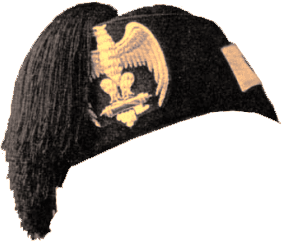
There were 100.000 men, its chief was Alessandro Pavolini (secretary of PFR)
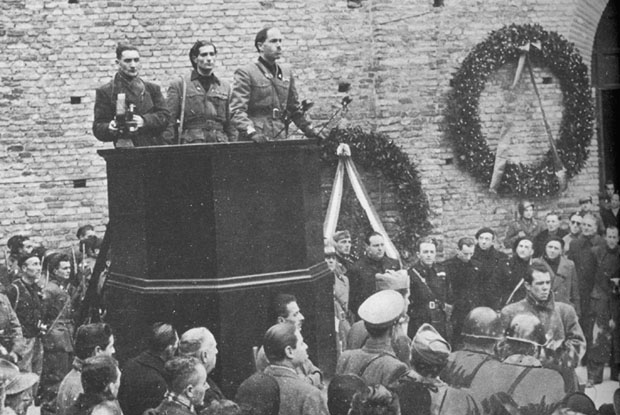 |
| Alessendro Pavolini(1903 1945) at the Ettori Mutti funerals In Ravenna |
It was created on 30th June 1944 when Partito Fascista became a military organism. Every 18 to 60 year old fascist who was not enlisted in any other auxiliary forces was enrolled in Brigate Nere
These units are composed of voluntaries and some of the oldest have known the walk on Rome in 1922 and they are helped by young people who are fanatics of the fascist cause. They are organised in 50 brigades and used as a police and they fight against partisans. They did not belong to the army and so are considered as auxiliary forces. They are known by their cruelty with captured partisans Ne faisant pas parties de l ‘Armée ils sont considérés comme forces auxilliaires.
All these brigades are named after a fascist ‘hero’ who was killed while fighting.
.jpg) |
.jpg) |
| Bologna Brigate Nera |
Novara Brigate Nera |
.jpg) |
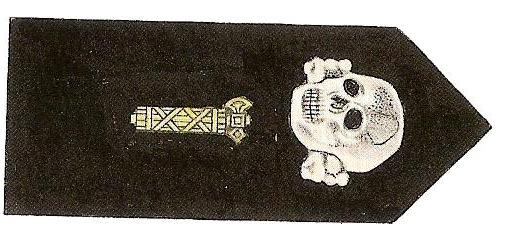 |
| Savona Brigate Nera |
Mantova Brigate Nera |
1st BN Territoriale Ather Cappelli - Turin
2nd BNT Attilio Prato - Alessandria
3rd BNT Emilio Picot - Aosta
4th BNTLuigi Viale - Asti
5th BNT Carlo Lidonnici - Cuneo
6th BNTAugusto Cristina - Novare
7th BNT Bruno Ponzecchi - Turin
8th BNTAldo Resega - Milan
9th BNT Giuseppe Cortesi - Bergame
10th BNT Enrico Tognu' - Brescia
11th BNTCesare Rodini - Como
12th BNT Augusto Felisari - Cremone
13th BNT Marcello Turchetti - Mantoue
14th BNTAlberto Alfieri - Pavie
15th BNTSergio Gatti - Sondrio
16th BNT Dante Gervasini - Varese
17th BNT Bartolomeo Azara - Venise
18th BNT Luigi Begon - Padoue
19th BNT Romolo Gori - Rovigo
20th BNT Francesco Cappellini - Trevise
21st BNT Stefano Rizzardi - Verone
22nd BNT Antonio Faggion- Vicenze
23rd BNT Eugenio Facchini - Bologne
24th BNT Igino Ghisellini - Ferrare
25th BNT Arturo Capanni - Forli'
26th BNT Mirko Pistoni - Modene
27th BNTVirginio Gavazzoli - Parme
28th BNT Pippo Astorri- Plaisance
29th BNT 29th "Ettore Muti- Ravenne
30th BNT Umberto Rossi - Reggio Emilia
3st BNT Silvio Parodi Genes
32nd BNT Antonio Padoan - Imperia
33rd BNT Tullio Bertoni - La Spezia
34th BNT Giovanni Briatore" - Savone
35th BNT Don Emilio Spinell" - Arezzo
36th BNT Benito Mussolini - Lucca
37th BNT Emilio Tanzi - Pise
38th BNT Ruy Blas Biag" - Pistoia
39th BNT ?? - Siene
40th BNT Vittorio Ricciarelli" - Apuania (which then became Brigata Nera Mobile)
41st BNTtRaffaele Manganiello Florence
1st Brigata Nera Mobile "Vittorio Ricciarelli" (then renamed 1st Brigata Nera Mobile Arditi I.Barattini)
2nd Brigata Nera Mobile Danilo Mercuri
3rd Brigata Nera Mobile Attilio Pappalardo
4th Brigata Nera Mobile Achille Corrao" ( then Brigata Nera ministeriale Meattini)
5rh Brigata Nera Mobile Emilio Quagliata
6th Brigata Nera Mobile Dalmazia
7th Brigata Nera Mobile Tevere
2nd1st Brigata Nera Mobile Arditi - Milano.
Independant Brigate Nere
Giuseppe Garibaldi Morbegno Brigade
Ministery Black Brigade 1st Brigata Nera Mobile Meattini – Brescia
Giovanni Gentile Black Brigade- Cremona
Tulio Cividino Black Brigade Trieste
Norma Cosseto women Black Brigade – Trieste
Young people action groups
Lombardie Butti Black Brigade
Cie Fascisti Black Brigade : Island of Rhodes (Egee sea)
Autonomous Units
Comando Controguerriglia
a cavalry company
a company equipped with 155mm guns
Centro Addestramento Reparti Speciali
1st Granatieri Btn
2nd Alpini Cadore Btn
2nd GNR
3rd GNR Btn
Raggruppamento Anti Partigiani
1st BTN
2nd BTN
3rd BTN
Reggimento Volontari Fiumani Tagliamento
1st, 2nd, 3rd Btns and 1st Btn Brigate Nere Btn
Reggimento Bersaglieri Volontari
15th Coastal defence Btn
1st Bersaglieri Mussolini Btn
2nd Bersaglieri Mameli Btn
3rd Bersaglieri Btn
101st complementary Btn
Unita' legionarie Italiane
officers’ Btn
Dibio volontary group composed of 3 Btns
Brigata Assalto Italiana
1st motorised infantry Rgt composed of 2 Btns
2nd motorised infantry Rgt composed of 2 Btns
4 artillery Btns
Coastal defence Units
1st Bersaglieri Btn
2nd Bersaglieri Btn
3rd Bersaglieri Btn
7th infantry Btn
8th infantry Btn
9th infantry Btn
10th Mountain troups Btn
11th Bersaglieri Btn
12th Infantry Btn
13th Infantry Btn
14th Brigate Nere Btn
16th Infantry Btn
17th Infantry Btn
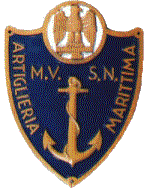
1st Coastal artillery Battery(10 batteries)
3rd Coastal artillery Battery (8 batteries)
5th Coastal artillery Battery (4 batteries)
9th Coastal artillery Battery (12 batteries)
13th Coastal artillery Battery (8 batteries)
15th Coastal artillery Battery (2 batteries)
17th Coastal artillery Battery (3 batteries)
Military engineering companies (fortifications)
116th, 122nd, 123rd, 124th, 125th, 126th, 132nd, 134th, 138th, 140th, 142nd, 143rd, 145th, 146th Btns
Some elrments from dissolved Btns are grouped altogether at the Centro Raccolta Complementi Genio, and 7 Btns are ready to be constituded(113th, 115 th, 117th, 135th, 119th, 151st, et 130th)
Military Enginnering Cos
6 Btns from 1st to 6th
For Tanks : see to ( http://www.maquetland.com Histoire )
In Germany
5 Anti aircraft Btns (fumes ) in the Baltic harbours
92th Brigate Nere Btn in Vienna
In France:
Volontaries Units
AOK Btn
6th Heavy artillery Btn in Bordeaux
In Grece
2nd Piemonte artillery Btn
8th machine gunners Btn
7th RI
24th Carroccio Brigate Nere Legion, 1st infantry Btn 1st artillery Btn
In Croatia
49th Brigate Nere Marche Legion
In Montenegrin
72nd Brigate Nere Legion ( 3rd and 72nd Btns)
86th Brigate Nere Legion (86th and 94th Btns)
81st, 82nd, 40th, 49th, 33rd, 111th, 114th Brigate Nere Brns
In Russia
834th Field Hospital
Others
44th garrison Co
6th Arditi (commandos)
221st "Italianité all'Estero" Legion
6th Artillery Btn composed of 3 batteries
Servizio Ausiliario Femminile S.A.F.
It was created thanks to a Ministry Decreet on 18th April 1944
7237 women integrated it
It structure was:
General Commandress was Countess Gatteschi Fondelli Piera,
its Vice Comandress was Dtssa Pancheri Cesaria,
It was composed logistic services such as :
Enrolment Office
Supervisory Staff Office
Press and Propaganda Office
Health Services
Administrative Services
Cooks
Anti aircraft Defence,
Class Office
Some of these women died (300 ) when Italy was freed
POLIZIA REPUBBLICANA
Polizia Repubblicana formed some units to fight against partisans.
the Polizia repubblicana chief commanded an Ispettorati Regionali, a parlementiary administrator, a Comando Forze Armate di Polizia.
There were 6 Btns “Italiana Polizia”, a Arditi di Polizia Legion called “Pietro Caruso” and a Mobile autonomous Legion called “Ettore Muti”
Legione autonoma mobile Ettore Muti
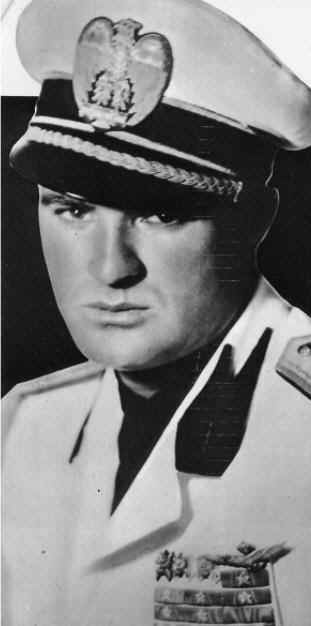 |
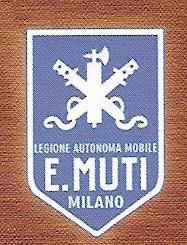 |
| Ettori Mutti (1902 1943) |
LAM MUTTI |
This force of 2300 men is described in the 3rd Part of the article about RSI (http://www.maquetland.com)

.jpg)

.jpg)

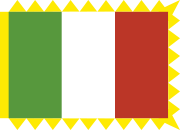










.jpg)
.jpg)
.jpg)




.jpg)
.jpg)

.jpg)

.jpg)
.jpg)
(1).jpg)
.jpg)
.jpg)




.jpg)
.jpg)
.jpg)
.jpg)
(1).jpg)


.jpg)

.jpg)
.jpg)
.jpg)
